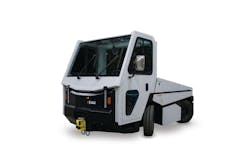Electric Tractors for Business, Regional and Military Aircraft

The next generation of Eagle Tugs has landed. The new ETT-X line of tractors from Eagle Tugs, a Tronair Company, is 100 percent electric and all-wheel-drive. Eagle Tugs has been supplying the aviation market with tugs since 1969, and the ETT-X family continues that history.
The ETT-X is available in two configurations. The ETT-8X was designed for an 8,000-pound drawbar pull and a towing capacity of 115,000 lbs. The ETT-12X is capable of a 12,000-pound drawbar pull and a towing capacity of 171,000 lbs. This translates to over 1,000 aircraft platforms making the ETT-X a green solution for a wide variety of aviation customers.
The next generation design was a collaboration between Tronair’s customers and Eagle’s experienced engineers.
“Valuable operator feedback helped the Eagle team shape our design to be safe, intuitive, robust and an enjoyable driving experience,” says Charles DeRaedt, Tronair’s vehicle product manager.
“With the tightest turning radius (135”) and lowest profile available, the new ETT-8X is the most compact tug on the ramp. In addition to a compact design and high-power towing capacity, our customers sought a sustainable solution to reduce their carbon footprint. With the aviation industry marching to the goal of net-zero carbon emissions, we knew a sustainable vehicle with a lithium-ion battery option was the perfect solution.”
Since the tug is all-electric, no emissions are generated by the vehicle, which means it’s healthier for ground crews.
“Traditional exhaust exits are at the rear of the vehicle, right where the ground crew is located during towing operations,” DeRaedt says. “Additionally, unlike their gas and diesel counterparts, battery-powered vehicles require no oil or filter changes – or associated costs. Without an internal combustion engine, the noise pollution is also reduced.”
Electric GSE (eGSE) is especially suited for aircraft towing and taxiing because aircraft towing does not usually require a vehicle to go a long distance. Most towing and pushback operations are only a few hundred feet. Based on vehicle usage and the time between aircraft movements, operators can use a vehicle for an entire shift or longer. With opportunity charging and the vehicle and charger at the same location, a vehicle can be charged during downtime.
“This can substantially increase the usage before the vehicle requires a full recharge,” DeRaedt says.
An optional “Smart Charge” battery and charger system allows the battery to be charged to maximize efficiency, with no reduction in battery lifecycle.
“Traditional chargers used on your car battery just pump energy into the battery. With a smart charger, the charger monitors multiple parameters of the battery and charges at the most efficient speed while maintaining battery integrity,” DeRaedt explains. “With smart chargers, you can maximize your time at the charging station.”
According to DeRaedt, the most commonly asked questions about the electric Eagle Tow Tractor are about lithium batteries and lead time for vehicles.
“We do our best to educate customers on the differences in battery options and the benefits of lithium,” DeRaedt says, adding that the ETTs can be equipped with lead acid or Li-ion batteries.
For ease of maintaining lead acid batteries, Eagle offers a single port and fill attachment to make battery maintenance more efficient.
With technology advancements, lithium batteries offer several advantages.
“Lithium batteries improve life expectancy while increasing safety,” he continues. “They can charge faster and more efficiently without off-gassing like lead acid. They do not require watering or maintenance aside from charging. An internal module controls discharge and charging to maintain the batteries, keeping them in optimum condition. The battery’s efficiency allows it to charge faster and gain more energy from regenerative braking.”
Regenerative brakes are key for extending battery life. Unlike traditional diesel tugs, an electric vehicle stops gradually when you take your foot off the accelerator. During this operation, the vehicle converts the potential energy of the vehicle back into battery power.
Safety Features
New safety features are included in both ETT models.
“One of the features Eagle has been known for is their dedication to safety by maintaining a sight tunnel throughout design iterations,” DeRaedt says. “The ETT-8X is no exception. We have added a window in the front of the operator compartment to allow visibility of the front hitch during towing operations at all times. We maintained a valley down the vehicle’s center in the rear to allow an unobstructed view of the rear hitch. The valley is painted black to reduce contrast and enhance the view of the hitch.”
In addition to the front and rear sight tunnels, the customer-requested optional backup camera provides improved backup visibility.
Front and rear inching switches are used to carefully move the vehicle forward or backward.
“This is critical during towbar connection to get the small adjustments. It also provides a safety feature of allowing complete control and visibility of the connecting operation. Once the switch is released, the vehicle stops completely,” he says.
Using these features, the operator can position the tug to capture the towbar smoothly, efficiently and safely, DeRaedt adds.
In the event of an emergency, front and rear emergency stop switches give line workers near the vehicle the ability to quickly and safely stop and shut down the vehicle.
Other built-in safety features include a seat kill switch, horn, backup alarm, seat belts and parking brake.
Tractor Design
Eagle went with a low-profile design to keep the vehicle’s footprint small and height low.
“This allows for better space management in hangars, operator visibility and clearance around aircraft,” DeRaedt says.
Keeping with Eagle’s heritage, the vehicle body incorporates the traditional white color. A two-color paint scheme was used to modernize the look: a black body with white panels and doors. Eagle has historically been known for “boxier” designs with a single mid-operator compartment. DeRaedt says Eagle added a slant back design to break up the body lines and switched to a front operator compartment.
Utilizing lessons learned from the automotive industry, Eagle optimized comfort for seating height, step height, steering wheel placement and other compartment features.
“The vehicle was designed to accommodate a wide spectrum of operators comfortably. With a tilting steering wheel and adjustable seat, operators can easily customize the vehicle to meet their individual comfort,” DeRaedt says.
The three-person compartment allows the transportation of two passengers, and a wing walker wand holder is integrated into the dash.
Underneath the dash, 12V access was included to quickly install a flight line operation radio. Also included is a USB port to charge tablets and other devices.
Options include a front and rear e-hitch, and multiple industry standard hitches are available.
A towbar head holder is available to store the towbar heads on the rear of the vehicle. Two baskets can be added on the vehicle’s driver side rear to store chocks. And to protect the rear doors, rubber decking is available.
“We often see operators throw chocks, cones, toolboxes and other equipment on these surfaces. This provides a way to protect these higher risk areas from damage,” DeRaedt says.
For operators in cold weather conditions, a heated cab is also available as an option.
When selecting an electric towbar tug, DeRaedt says consider the drawbar pull and weight of the aircraft that needs to be towed. Also, he says to consider which battery option fits best and the charging capabilities on site.
About the Author
Rebecca Kanable
Assistant Editor
Rebecca Kanable, a veteran journalist, worked with Endeavor Business Media's aviation group from 2021 to 2024 as assistant editor of Airport Business, AMT and Ground Support Worldwide. She previously worked for various publications, including trade magazines and newspapers.
